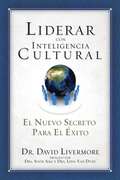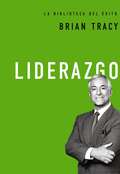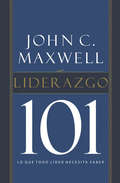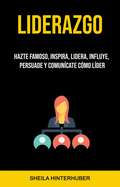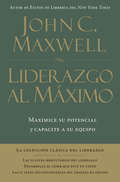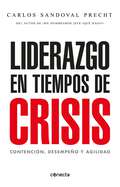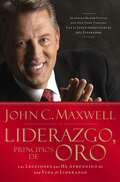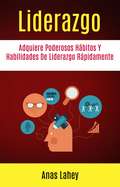- Table View
- List View
Liderança: Um Livro Sobre Liderança , Tomada de Decisão e Sucesso
by Akshat AgrawalEste livro irá lhe ensinar técnicas efetivas para que você se torne um líder ainda melhor. todos ansiamos por dias melhores; é isso que nos faz levantar de manhã cedo e fazer o que gostamos de fazer.Mas, o que será que nos faz ter ainda mais vontade, mais força ao ponto de atingirmos objetivos que não normalmente não conseguiríamos obter? seria isso a paixão por alguma atividade? e se fosse mesmo paixão, então por quê nós não temos esse mesmo sentimento em relação à outras coisas? Networking é essencial para uma liderança efetiva nas empresas dos dias atuais. Líderes que possuem facilidade em criar networking têm meios para chegar nas pessoas certas, nas informações certas e também possuem os recursos para resolver problemas e criar oportunidades. Os líderes que não se importam com networking acabam perdendo uma peça muito importante para exercer o papel de liderança. Este livro ajudará líderes a ver o networking sob um novo prisma e também ajudará nos insights que levarão os líderes a uma melhora na sua capacidade de fazer networking, e com liderança.
Liderar con inteligencia cultural
by David LivermoreLiderar con inteligencia cultural es una guía revolucionaria para desarrollar el repertorio y la perspectiva a la hora de liderar en una amplia variedad de culturas, con eficacia, respeto y seguridad. David Livermore, uno de los mejor especialistas mundiales en liderazgo, nos presenta un modelo probado para cualquier contexto cultural desconocido. Es fácil de comprender y de seguir, aunque radicalmente diferente a los acercamientos simplistas que se centran en imitar los gestos y frases de la otra cultura. Enraizada en una rigurosa búsqueda extendida a 25 países, el modo en que la Inteligencia Cultural relaciona e inspira a personas de diferentes nacionalidades, etnias y grupos es un ciclo continuo.
Liderar millennials. ¿Utopía o realidad?
by Marc Prenafeta Cruellas¿Es posible liderar millennials con éxito y no morir en el intento? La gestión de las personas siempre ha sido la clave para el buen funcionamiento de cualquier organización. Con la llegada de los millennials al mundo laboral, esta gestión ha pasado a un nivel superior. A través de ejemplos reales, el lector podrá entender mejor cómo gestionar a los millennials y obtener claves y herramientas para poder aprovechar al máximo sus grandes cualidades.
Liderazgo (La biblioteca del éxito #1)
by Brian TracyNadie nace como líder natural. Pero, ¿qué es lo que transforma a algunas personas en el tipo de individuos magnéticos que inspiran a otros a seguir? El experto en éxito Brian Tracy ha ayudado a miles de personas a convertirse en líderes excepcionales y ahora, en este libro conciso e intenso, revela cómo puede: Inspirar confianza, seguridad y la lealtad * Inculcar un sentido de significado y propósito en su organización * Acceder a la motivación y entusiasmo que impulsa a otros a comprometerse con su visión * Pensar estratégicamente --manteniendo el cuadro completo en mente * Enfocarse continuamente en el futuro * Convertir la adversidad en oportunidad * Tomar el tipo correcto de riesgos * Comunicar claramente sus objetivos y estrategias y lograr apoyo * Crear equipos ganadores * Obtener resultados extraordinarios de gente ordinaria * Cultivar relaciones valiosas y apoyar la Ley de la reciprocidad * Convertirse en la persona considerada la más probable en llevar a la organización a la victoria * Y mucho más El liderazgo no es un misterio. Es una habilidad que se puede aprender. Lleno de prácticos métodos comprobados, esta pequeña guía indispensable le ayudará a desatar el potencial de liderazgo.
Liderazgo 101
by John C. MaxwellTomado de los bestsellers de John Maxwell, Liderazgo 101 explora los principios eternos que han pasado a ser parte del estilo del doctor Maxwell. En un estilo conciso y directo, Maxwell se concentra en las cualidades esenciales y probadas, necesarias para un verdadero liderazgo (influencia, integridad, actitud, visión, solución de problemas y autodisciplina) y guía al lector en los pasos necesarios para desarrollar un verdadero liderazgo en su vida y en la vida de otros.
Liderazgo : Consejos De Gestión Para Ser Un Mejor Líder Y Aumentar La Productividad ( Leadership)
by Colonel RingDesafío de Liderazgo es el manual de oro para un liderazgo efectivo, basado en la investigación y escrito por las principales autoridades en el campo. Con una visión profunda de las complejas dinámicas interpersonales del lugar de trabajo, este libro posiciona el liderazgo como una habilidad que debe aprenderse y como una relación que debe fomentarse para alcanzar su máximo potencial. Esta sexta edición ha sido revisada para abordar los desafíos actuales, e incluye más ejemplos internacionales y un enfoque directo en temas de negocios; aprenderá cómo los líderes extraordinarios logran cosas extraordinarias y cómo desarrollar sus habilidades y estilo de liderazgo para brindar resultados de calidad en todo momento. Las interesantes historias profundizan en los roles fundamentales que cumplen los grandes líderes, cada temática proporciona una guía para aquellos que buscan la mejora continua; Al internalizar las ideas clave y poner los conceptos en acción, se convertirá en un líder más efectivo e impactará a otros. Si está listo para actuar y llevar su vida al siguiente nivel, ¡este libro definitivamente lo guiará en la dirección correcta!
Liderazgo : Guía De Gestión Para Ser Grandioso Influenciando Y Comunicando ( Leadership)
by David PopovichLeadership Agility es la competencia maestra necesaria para el éxito sostenido en el entorno empresarial complejo y acelerado de hoy. Ricamente ilustrado con historias basadas en investigaciones originales y décadas de trabajo con clientes, este libro innovador identifica cinco niveles por los que los líderes avanzan en el desarrollo de su agilidad. Significativamente, solo el 10% ha dominado el nivel de agilidad necesario para lograr una efectividad consistente en nuestra era turbulenta de competencia global. Escrito en un estilo atractivo y realista, este libro no solo proporciona un mapa que guía a los lectores a identificar su nivel actual de agilidad. También proporciona consejos prácticos y ejemplos concretos que muestran a los gerentes y profesionales de desarrollo de liderazgo cómo pueden aportar mayor agilidad a las iniciativas que toman todos los días. Si está listo para actuar y cambiar su vida para mejor, ¡este libro definitivamente lo guiará en la dirección correcta!
Liderazgo : Hazte Famoso, Inspira, Lidera, Influye, Persuade Y Comunícate Cómo Líder
by Sheila HinterhuberEste libro es una guía de ayuda para estudiar a la gente y convertirte en esa persona increíble a sus ojos. Para saciar nuestra sed de ser amados, debemos mostrarnos adorables y atractivos. La seguridad en ti mismo, una sonrisa cálida o un fuerte apretón de manos son suficientes para empezar a ascender en tu movido viaje a la cima. Este libro intuitivo es el fruto de unas cien entrevistas con líderes de todo el mundo, Autores como Richard Banfield, Martin Eriksson y Nate Walkingshaw se beneficiaron de décadas de experiencia en el diseño de productos y su desarrollo, para atrapar los enfoques, los estilos, los puntos de vista y las técnicas de productos estrella. Si quieres entender qué es lo que impulsa a los líderes de los productos punteros, este libro es un recurso indispensable. ¡No esperes a pasar a mejor vida, para descubrir el secreto!
Liderazgo : Libro De Gestión Empresarial Para Influir Y Comunicarse Mejor
by David BaillyLiderazgo ... Bíblicamente hablando es una guía del mundo real para el liderazgo cristiano en el mundo de hoy. Identifica doce rasgos de liderazgo requeridos para el éxito y te muestra cómo tener éxito mientras sigues los principios de liderazgo comprobados en la Biblia. El libro está rodeado de escrituras que validan los doce principios. El autor también se ha mezclado en historias y analogías para hacer que el libro sea aplicable a los líderes de hoy en todos los niveles y organizaciones. Es hora de ir a tu nuevo papel ejecutivo, y la presión está en aumento. Se espera que usted se ponga al día y agregue valor al negocio , rápido. Como célebre estratega de liderazgo y coach ejecutivo, Hilary Potts está aquí para ayudar. Ella ofrece principios y prácticas poderosos para lograr una transición más inteligente y sin complicaciones. Brillará a cada paso y establecerá el escenario para el éxito más allá de su transición.
Liderazgo : Métodos Definitivos Para La Motivación, La Influencia Y El Exito
by Ken ValseEste libro contiene pasos y estrategias comprobadas sobre cómo convertirse en un verdadero líder, cómo inspirar a otros en el sueño que comparten juntos y cómo trabajar juntos para hacer que ese sueño se convierta en realidad, trabajando lado a lado, mano a mano. No solo eso, este libro también trata sobre lo que realmente es el liderazgo, y cómo la sociedad ha visto a una serie de grandes líderes cambiar los cursos de la historia a lo largo de los siglos. También he agregado una lista de cualidades que generalmente encontramos en un buen líder, cualidades que pueden ser comunes en un ser humano pero que aún así son importantes. Por último, este libro también contiene algunos pasos comprobados y definidos sobre cómo desarrollar sus habilidades de liderazgo para que pueda convertirse en el tipo de líder que el mundo necesita, y el tipo de líder que usted mismo podría seguir.
Liderazgo Eficaz: Un libro para líderes, escrito por un líder sobre el Líder supremo de todos los tiempos
by John C. MaxwellLiderazgo eficaz es la herramienta que todo creyente debe estudiar para enriquecer su función dirigente en el cuerpo de Cristo y en cualquier otra área a la que el Señor le guíe. El autor, John Maxwell, anima la individualidad en cada persona, de modo que no necesite tener a su lado personas complacientes que lo hagan quedar bien como líder. Esta obra considera las cualidades que necesitamos desarrollar en nuestra vida, mismas que disfrutamos al ver en los demás. Nos muestra también la influencia que ejerce cada persona en su entorno y cómo debemos aprovechar nuestros recursos para influir de la manera correcta en las vidas que nos rodean. La obra trata asuntos cruciales como: ¿Cuál es la clave para relacionarme bien con los demás? ¿Qué les atrae a las personas? ¿Qué atrae a las personas hacia mí? Sea alguien digno de seguir. Motive a las personas. Cómo ganar el respeto de los demás. Desarrolle un equipo ganador.
Liderazgo Quántico
by Jorge CuevasLas cuatro etapas para impulsar tu familia, tu empresa y tu comunidad. Un cambio que inicia en uno, un cambio quántico, contagia a toda la comunidad, porque el líder quántico es aquel que hace cambios profundos en sí mismo, y su transformación es tan grande que genera efectos a su alrededor, a cualquier nivel: personal, familiar, laboral, económico. En épocas de crisis, cuando alguien se rinde y cierra su negocio, hay una influencia en todo su entorno: el miedo, el pesimismo y el desánimo se contagian rápidamente. De la misma forma, si tú estás creciendo, no es necesario que intencionalmente quieras contagiar a los demás, porque de todas formas lo estás haciendo. Tus acciones, tus intenciones, tu estado mental y emocional trascienden, e influyes de manera natural en las personas que te rodean porque tú y los demás son parte de un mismo sistema. Liderazgo Quántico te enseña cómo comenzarcon un átomo y revolucionar toda la existencia. ¡Estamos entrenando a México!
Liderazgo Quántico
by Jorge CuevasLas cuatro etapas para impulsar tu familia, tu empresa y tu comunidad. Un cambio que inicia en uno, un cambio quántico, contagia a toda la comunidad, porque el líder quántico es aquel que hace cambios profundos en sí mismo, y su transformación es tan grande que genera efectos a su alrededor, a cualquier nivel: personal, familiar, laboral, económico. En épocas de crisis, cuando alguien se rinde y cierra su negocio, hay una influencia en todo su entorno: el miedo, el pesimismo y el desánimo se contagian rápidamente. De la misma forma, si tú estás creciendo, no es necesario que intencionalmente quieras contagiar a los demás, porque de todas formas lo estás haciendo. Tus acciones, tus intenciones, tu estado mental y emocional trascienden, e influyes de manera natural en las personas que te rodean porque tú y los demás son parte de un mismo sistema. Liderazgo Quántico te enseña cómo comenzar con un átomo y revolucionar todala existencia. ¡Estamos entrenando a México!
Liderazgo al máximo
by John MaxwellEmpiece su biblioteca de liderazgo con este tomo de tres libros en uno.Tres obras clásicas de Maxwell sobre liderazgo han sido reunidas en un solo volumen: Las 21 leyes irrefutables del liderazgo, Desarrolle el líder que está en usted y Las 17 leyes incuestionables del trabajo en equipo.Los principios probados que se hallan en estos tres libros en suversión completa pueden ayudarle a marcar la diferencia mañana alllegar a ser un mejor líder el día de hoy. Si usted tiene el deseo dedirigir, estos libros pueden ayudarlo a desarrollar la visión, losvalores, la influencia y las habilidades requeridas para un liderazgoexitoso.
Liderazgo en tiempos de crisis
by Carlos SandovalContención, desempeño y agilidad. Carlos Sandoval Precht es licenciado en Filosofía, magíster en Dirección y Gestión del Capital Humano y (c) Magister en ciencias Políticas. Posee un diplomado en Desarrollo Organizacional, en técnicas de Dramaterapia y Coaching. Desde 1998 se desempeña como consultor organizacional en temas de liderazgo, trabajo en equipo y efectividad organizacional tanto en Chile, América Latina como Estados Unidos. Socio fundador de SP Consultores y profesor de habilidades directivas en el Magister de Gestión Escolar de Fundación Chile/UDD y en el Programa MBA y en Educación Ejecutiva de la Universidad de Santiago de Chile. Ha publicado, entre otros, los libros Me nombraron jefe ¿qué hago? (traducido al inglés), De jefe a líder y 20 filósofos visitan su empresa, todos disponibles bajo el sello Conecta. carlossandoval@spconsultores.cl
Liderazgo exitoso: Ideas para alcanzar tu máximo potencial
by Bernardo StamateasEn Liderazgo exitoso Bernardo Stamateas presenta todos los conceptos esenciales y los puntos clave sobre el liderazgo para que puedas comprenderlos fácilmente. Además, propone una autoevaluación que te ayudará a prepararte para una posición de liderazgo. Para muchos, ser líder es un don, una habilidad con la que algunos nacen y otros no. Parece que fuera natural. Pero a ser líder también se aprende. Porque todos, de una u otra manera, ejercemos influencia en algún ámbito de nuestra vida. No se trata de títulos ni de poder. Se trata de encontrar en nosotros el potencial para serlo. En este nuevo libro, Bernardo Stamateas presenta los principios y las herramientas prácticas para ayudar a superar la adversidad y mejorar la comunicación, el compromiso y el rendimiento. ¿Qué hace un líder? -Administra el poder que le da la gente-Tiene autoridad y da órdenes-Aprende y enseña con eficacia-Arma equipos y maneja grupos Liderazgo exitoso marcará un antes y un después en tu vida. Te enseñará a liberar tu máximo potencial y a llevar grandes resultados a tu gente.
Liderazgo, principios de oro: Las lecciones que he aprendido de una vida de liderazgo
by John C. MaxwellEscribir Liderazgo, principios de oro le llevó a Maxwell toda una vida, y ofrece sus lecciones más valiosas basadas en cuarenta años de liderazgo.Un líder entre los líderes, John Maxwell se prometió a sí mismo al comienzo de su carrera que no escribiría este libro hasta tener sesenta años de edad. Y ahora finalmente está aquí. Con su estilo característico, Maxwell se pone al lado de uno como mentor, haciendo que los lectores sientan como si fuera un programa individual de liderazgo. Liderazgo, principios de oro ofrece lo mejor de lo mejor, las lecciones probadas y veraces que nadie sino Maxwell puede compartir.
Liderazgo: Adopta Habilidades Efectivas Como Influenciar, Comunicar Y Tomar Decisiones
by Matt HigginsEste libro es perfecto para individuos y grupos que navegan para convertirse en mejores líderes. Ya sea que seas un CEO o un gerente de recursos humanos que comienza su carrera con el deseo de afinar sus habilidades de liderazgo, o estés recibiendo capacitación ejecutiva para líderes de marcas y organizaciones sin fines de lucro, The Leadership Killer puede ayudar a guiarte en la dirección correcta. Este libro contiene mucha información esencial e interesante sobre Lee Kuan Yew, el padre fundador de Independent Singapore. La noticia más impactante del 23 de marzo de 2015 fue que Lee Kuan Yew había fallecido. Este libro pretende ser una memoria de Lee Kuan Yew y un registro de sus increíbles logros para Singapur durante su reinado. Al leer este libro sobre Lee Kuan Yew, la generación joven puede aprender sobre su liderazgo carismático, los hitos clave durante su reinado y los legados invaluables que dejó a los singapurenses. No esperes más para descubrir TU LLAVE hacia una vida nueva y mejor.
Liderazgo: Adquiere Poderosos Hábitos Y Habilidades De Liderazgo Rápidamente
by Anas LaheyEste libro es un deleite para los practicantes. Tómalo y adelántate al resto. Sigue estas instrucciones y las personas literalmente morirán por ti, incluso en lo referente a organización empresarial. Muestra por qué la industria del liderazgo está fallando y cómo podría ser reconstruida. Establece los atributos que a menudo la gente espera conseguir en los líderes: que sean honestos, auténticos y modestos, digan la verdad, creen confianza y se ocupen de los demás. Al mencionar a BS en muchas de las historias y mitos del liderazgo, le da al lector una visión más científica de la evidencia y una mejor información para guiar su carrera. ¿Que estas esperando? ¡No esperes más! Busca y haz clic en el botón de comprar ahora para comenzar el viaje a la vida de tus sueños.
Liderazgo: Aprender a motivar, Influencia, plomo e impulsar una productividad de su equipo de manera correcta"
by Akshat AgrawalEsta dedicado a la formacion de lideres y crear seres exitosos
Liderazgo: Consejos Para Inspirar, Influir Y Tomar Decisiones Como Un Jefe
by David LewisEl liderazgo es engañoso. Nada es constante. Las circunstancias cambian de día en día y de momento a momento. Muchas veces, la mejor “herramienta” que tenemos es nuestra intuición, basada en parte en la sabiduría de nuestras experiencias y en parte en puro instinto. En mi experiencia como facilitador corporativo y mentor de desarrollo en liderazgo, he encontrado que los líderes más efectivos son los que pueden realizar una profunda autorreflexión de sus propias “verdades” y expresar con valentía esas verdades a sus colegas, clientes y empleados. Esta no es una tarea fácil y muchos de nosotros podríamos necesitar ayuda. ¿Qué està esperando? ¡No espere más! ¡Mueva el cursor y haga clic en el botón de comprar para iniciar el viaje de sus sueños!
Liderazgo: El Libro Definitivo Que Mejora La Comunicación, Influencia Y Administración De Negocios
by James FowlerEl libro definitivo para mejorar la comunicación, la influencia y la administración de negocios. Dentro encontrarás no solo diez pasos para mejorar tus habilidades de liderazgo, aunque eso también está, encontrarás una guía completa para ayudarte en tu viaje al liderazgo. Aprenderás formas de inspirar a otros y consejos que los líderes efectivos usan para comunicarse con sus equipos. Con esos principios en mente, "Liderazgo: 10 pasos para ser un líder exitoso" continúa para analizar cosas esenciales que todo líder necesita saber para desarrollar un equipo exitoso, los inquilinos centrales detrás de la delegación efectiva y con cuanta efectividad los líderes resuelven tanto el estrés como el fracaso. Esta colección de frases de liderazgo contiene frases de voces populares en el liderazgo y algunas nuevas y sin embargo sabias. Las frases son declaraciones de líderes de negocios, presidentes, hombres y mujeres en las fuerzas armadas, líderes religiosos y gente cotidiana. La sabiduría de estas frases te alentará a ser el mejor líder que puedas y te motivará en días en que el liderazgo parece difícil. Si estás listo para actuar y cambiar tu vida para mejor, ¡este libro definitivamente te guiará en la dirección correcta!
Liderazgo: Equipo De Gestión E Influencia Para Una Mejor Productividad
by Archie RidgwayLa creencia de que nacemos y crecimos con límites nos roba muchas posibilidades y oportunidades. Estos lentes a las que estamos acostumbrados nos ciegan de la verdad. Ahora es el momento de quitarse esas lentes y ver el verdadero mundo y cosechar las abundantes oportunidades que no creías que podían ser tuyas. Este libro te ayudará a desarrollar tu presencia de liderazgo. Los autores ofrecen un marco simple y convincente, así como prácticas para desarrollar su "voz de firma". Donde sea que te sientes en una organización, puedas desarrollar presencia si puedes hacer dos cosas bien: demostrar tu valor y distinción auténticos; y conectarte con otros de una manera positiva. Los líderes que pueden ser auténticos mientras se conectan e impactan con otros tienen lo que los autores llaman una voz de firma, un medio de autoexpresión que es único y claramente suyo. Una vez que aceptes y expreses esta habilidad invaluable, no creerás el tremendo impacto que puedes tener en quienes te rodean. Lleno de historias y ejemplos de la vida real, Own the Room desmitificará la noción de presencia y brindará consejos prácticos sobre cómo desarrollarla.
Liderazgo: Habilidades Para Una Mejor Toma De Decisiones, Mejor Persuasión Y Crecimiento Personal
by Darren WesternLas cualidades, estilos y características de liderazgo han sido estudiadas y debatidas durante siglos. ¿Cómo sé qué estilo de liderazgo sigo más? ¿Cuáles son las quince características de un liderazgo efectivo? Encontrar al líder en ti te ayudará a identificar al líder en los demás y te hará más exitoso. El resultado final es siempre superar y sobresalir. Las habilidades de gestión son críticas, pero no suficientes para proporcionar excelencia. La excelencia exige un gran liderazgo. Esta guía te ayuda a encontrar esa excelencia y cualidades para ser un líder exitoso. Antes de que puedas convertirte en un buen supervisor o gerente, debes aprender a ser un líder. El liderazgo es el primer paso para convertirse en alguien que puede lograr objetivos al administrar personas. De eso se trata Liderazgo: El primer paso. Proporciona pautas y consejos para el supervisor o gerente que inicia: consejos que les permitirán no solo administrar sino también dirigir a las personas y tener éxito. Incluye capítulos y secciones sobre disciplina, organización, enseñanza, dar un buen ejemplo personal, buenos hábitos de trabajo, seguridad, reuniones de personal y mucho, mucho más.
Liderazgo: Habilidades Supremas Para Ser Un Líder Eficaz Para Influenciar Y Tomar Buenas Decisiones
by Michael JosephsEl liderazgo puede ser duro. Te puede mantener despierto en la noche. Puede hacer que desees renunciar a una vida en una sociedad civilizada y convertirte en un habitante de cuevas en una tierra muy, muy lejana. Si te acaban de dar un trabajo de liderazgo, pronto descubrirás que la realidad puede ser mucho más desafiante de lo que le dicen los libros de texto. Si has estado en el liderazgo durante un tiempo y tienes dificultades, tal vez lo que necesitas es recordar los aspectos fundamentales que te sostendrán en los momentos difíciles (y te ayudarán a mantener tu trabajo). Una de las peores falsedades que el diablo le vendió a la Iglesia está relacionada con el liderazgo. Y desafortunadamente, compramos y promovimos esa idea del diablo sobre el liderazgo. El resultado es que los líderes de la Iglesia se presentan como reyes, mientras que los miembros son los esclavos. Se presentan como comandantes militares mientras que los miembros son los soldados. Esta es probablemente la razón principal por la cual la iglesia ha perdido su salinidad. En este pequeño libro, el Dr. Olowosoyo intenta corregir ese error.

